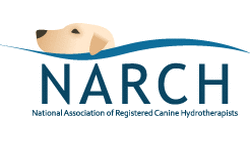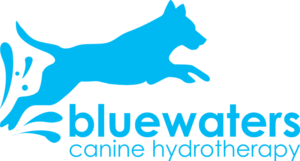Canine Hydrotherapy…
Canine Hydrotherapy…
What is Canine Hydrotherapy?
A non or partially weight bearing exercise utilising the therapeutic properties of warm water. Swimming and water walking sessions carried out by trained hydrotherapists to improve a dogs fitness and function. All cases are treated differently and respond in varying degrees. For some dogs simply floating/sitting or free swimming gently in the warm water pool can relieve pain and inflammation.
For other dogs more vigorous exercise is used to improve range of movement, tone muscles and increase strength. When used after surgery or injury this can aid the patient to a speedier recovery. The benefit of buoyancy supports dogs in a non-weight bearing or partially weight bearing environment thus allowing movements that would not be possible on land, due to a weakness or injury. This is particularly useful for dogs that have spinal conditions. For dogs on restricted exercise or crate rest swimming can also reduce frustration.
At Bluewaters, dogs are treated in the Canine Hydrotherapy Pool or Underwater Treadmill for Dogs.
What can Canine Hydrotherapy Sessions be used for?
Orthopaedic conditions
Neurological conditions
Soft tissue injuries
Degenerative conditions
Age related mobility problems
Weight management
Gaining confidence around water
General fitness & fun
Conditions that Benefit
Osteoarthritis | Patella Luxation | Hip & Elbow Dysplasia | Cruciate Ligament Rupture | Spinal Injuries | Degenerative Myelopathy | Intervertebral Disc Disease | Osteochondritis Dissecans |
Weight Loss
Swimming is a great cardiovascular workout, along with a controlled diet can make for fantastic weight loss results as well as building muscle and fitness levels.
Fitness & Fun
There are many dogs who come to Bluewaters to swim simply for fun and general fitness. Swimming is a great cardiovascular work out for keeping dogs fit and in peak physical condition.
Puppies
It is an ideal exercise for puppies, putting no pressure on growing joints whilst giving them swimming skills for life. Bluewaters swim puppies from four months upwards.
Water Confidence
If your dog is nervous around water the pool environment is an ideal place for them to overcome that fear. With encouragement, toys & small treats in a controlled environment your dog can learn to swim without fear.
What happens in a typical canine hydrotherapy session?
You and your dog/s will be welcomed into the centre and at your first session will be given a short introduction about how our centre operates. Our canine hydrotherapist will check your dog’s veterinary referral form and will talk to you about your concerns, questions and goals for hydrotherapy. She will then give your dog a health check before being fitted with a buoyancy aid or harness.
Your dog will be encouraged into the pool to swim for short bursts with rest breaks on the ramp. The hydrotherapist will then shower your dog, shampoo if required and dry your dog using towels and dryer if your dog is comfortable with it. All findings from the session will be explained to you along with post swim advice.
How should I prepare my dog for the hydrotherapy session?
Veterinary Referral – Please request from Bluewaters or download a veterinary referral form from this website to give to your vet to sign. This is required for all types of swim session, including fitness/recreational swims. Please bring your form with you to your dogs first swim.
Feeding & Toileting – Dogs should not be fed for at least 2 hours before swimming and also not fed for about 2 hours after swimming. If your dog is on medication which needs to be taken with food then the swimming sessions should be booked for around 3 hours after they have been fed. They should go to toilet before swimming.
After the session – Please keep your dog warm and allow to rest – but no longer than an hour or they may get stiff. A gentle 5 minute walk or potter in the garden about an hour or so after the session is a good idea. Any concerns should be expressed to Bluewaters and/or your veterinarian.
See our Canine Hydrotherapy Case Studies page.
Contact




